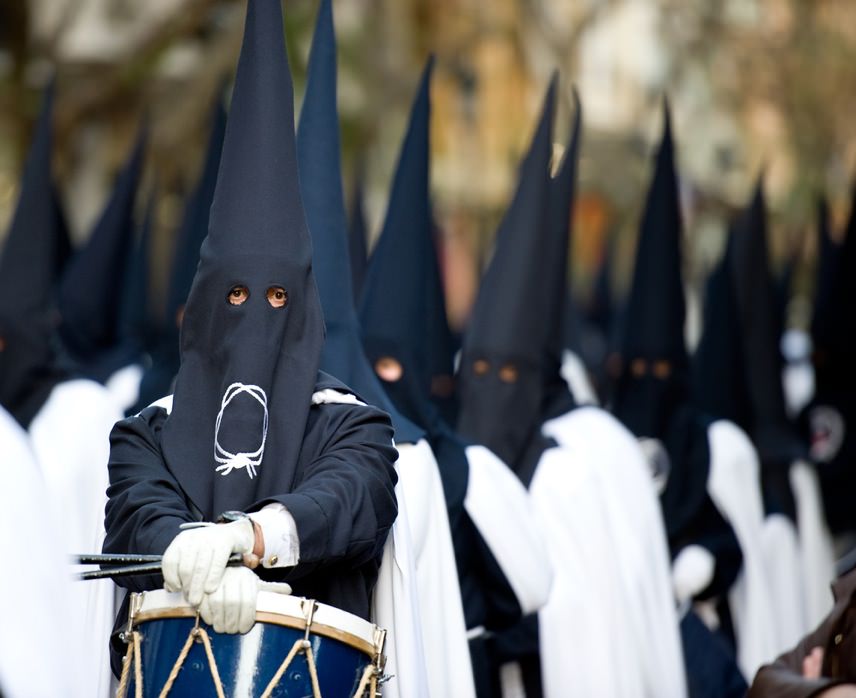What to expect for Easter in Spain 2015

This year Easter in Spain will fall on Sunday April 5th. But in Spain the celebrations start with Carnival and end with a full week of activities during “Semana Santa” or holy week. Semana Santa is one of the most passionate and important celebrations of the year and is celebrated in every corner of Spain. No matter where you are in Spain during Easter week you are bound to run across at least one of its famous processions. Some processions are quite solemn and sober punctuated with trumpets or drums.
A typical procession during Semana Santa in Spain
The easter processions start on Palm Sunday and go on through Easter Sunday with dozens of Cofradias participating. These processions are organized by different brotherhoods or fraternities of catholic churches in each town and have their roots back to the middle ages. The most elaborate and glamorous of the procession are in Andalucia in Seville and Malaga, the largest of which are broadcast on national television. Great “Pasos” or floats are built to carry figures that depict scenes related to the Passion of the Christ and the Sorrows of the Virgen Mary. Some floats, originally designed by artists and built by the brotherhoods have been preserved for hundreds of years and are still inure today.
In the Cofradias there are two principal participants, the Costaleros and the Penitentes with the Costaleros carrying the float and the Penitentes leading and following the Costaleros.
Cofradias – “brotherhoods” are religious associations (usually member of a particular chuch congregation) that organize and care for the images of Jesus Christ and Mary throughout the year. Each Cofradia has a float with their particular “imagen” of Christ and or Mary.
Costaleros are the men who carry the floats.
Penitentes also known as “Nazarenos” lead and follow the float bearing traditional Capirotes.
The floats can weigh over a thousand pounds and are decorated with flowers, candles, and religious paraphernalia. Most people from the United Staes are surprised by the costumes as they look like the outfits worn by the KKK, but he Spanish rational for wearing these striking costumes in based in penance and forgiveness and not anything related to the KKK.
I remember my very first experience regarding Easter in Spain. I happened to be in Santiago Compostella with friends, one of whom is American. It was my first year in Spain and despite the fact that I am Catholic I really had forgotten it was Easter that week. We were wondering the old town and turned a corner and came across a cobbled stoned street lined with onlookers. My friend and I could not believe what we saw. About one hundred people dressed in deep purple robes with pointy hats (Capriotes) that looked exactly like what I knew to be KKK outfits, carrying an alter like float with candles and flowers covering it and a virgin Mary perched on the top of it. Standing there, jaws on the ground we looked at each other and said “what the hell is going on in this town?” It was a total surprise, I had never really seen anything on Spanish Easter. Our spanish friends looked at our horror struck faces, laughed and then began to explain the story of semana santa and what became to be known amongst the two of us as the “creepy semana santa” outfits.
The “capirote” (the cone shaped hat) symbolizes rising toward heaven. Their identity is hidden from the public so they can mourn the pain in suffering of Jesus privately. It is also an equalizer making all the participants the same and not distracting anyone from the task at hand. On Easter Sunday,the capriote is removed in celebration of the resurrection.
These processions are a far cry from the typical party atmosphere that generally happens during Spanish festivals. It is a very dramatic and passionate event to witness. The processions can last up to nine hours like the “Procession del Encuentro” in Léon, where 4000 penitents carry 13 “pasos” around the city. There are more lively processions with drums like that of the Tamborada of Hellin in the province of Albacete where they have up to 20,000 drums playing in the center of town.
Many of the processions are truly beautiful but are quite slow and a bit dramatic. After about ten or fifteen minutes of watching penitents walk to solemn drums you will be ready for a glass of wine and a tapa or two.
Glossary
Pascua = Easter
Semana Santa = Holy Week
A Faja is a belt worn around the waist of the costalero, it acts as a back support to heñp resist the strain of the weight of the float
Penitentes also known as “Nazarenos”. These participants wear costumes–(capas, capirotes, and capuces) the entire week, while processing up and down the streets in the Semana Santa parades. They are symbolic of those undergoing public penance for their wrongful deeds.
Capa is the cape worn during Holy Week by Penitentes.
Capirote is the cone-shaped headdress worn on the heads of Penitentes.
Capuz is the part of the headdress that covers the face and the cone-shaped capirote of the Penitentes.
Tunica is the robe worn by the Penitentes under their capas
Weather during Easter in Spain
People always ask me, “what will the weather be like on Easter?” In all my years in Spain it is the one week of the year that I can confidently say that it will rain at some point during Semana Santa no matter where you are in Spain. The last few years it has been a bit chilly, windy and always with rain. This is not to say there wont be any sun but be prepared and check the forecast before you pack!
You will need a wind breaker, umbrella, AND sun glasses. Consistent rain or heavy rain will delay processions. The floats are covered in flowers and candles and easily ruined by too much rain. It has been especially rainy in Seville the past few years and as I said, they take their processions very much to heart. I have seen people crying their eyes out on national television because it was raining during a procession.
In general the weather is better down south. Average maximum high of 73º F can be expected in April in Seville or 57ºF high in Santiago in the north. Madrid is the kind of place you need a jacket in the shade but if you are sitting on a terrace in the sun you can be in short sleeves soaking up the sun and your wine.
Plan ahead
In general easter week is a busy time in Spain, all the locals are out and about because most get the week off work. So not only do you have tourists but also the locals with their families out in force. Destinations like Seville and Malaga are booked weeks in advanced. However, there are a few places that might not be as busy…
Two years ago I had a friend who wanted to get away for Easter break. I had told them make sure you let me know before you make your reservation because some places may be shut down. (depending on the year easter may be earlier or later and fall within “off season” or shoulder season especially on the Balearic islands.) Well, they made reservations to go to Mallorca, prepaid the hotel and flights. The day they left I had received a message that they were off for their easter break on Mallorca. I saw the message and thought, oh boy, this will not end well.
Upon their return I got the whole story. They flew to Mallorca and had realized the hotel they booked was on the north side of the island on the beach near Alcudia. They had to hop on a public bus to get up there as they had not rented a car. And when they finally reached the hotel it looked as if it was closed. Chairs upside down on all the tables, windows covered, furniture covered and of course it was rainy and cold. They found a lone employee who asked what they were doing there. They then pulled out their hotel confirmation from Booking.com to show him that they indeed had a confirmed reservation at this very hotel that was currently closed and not due to open for one more week. The hotel honored the reservation and put them up in the only pension that was open on the beach. At this point they understood why their plane tickets were so cheap for Easter weekend. In the end they spent the weekend in the rain on an empty beach in a bar.
So please, do your research before you go or give me a call!
Ron recommends:
If you want to be experience the best of all the passion and drama, visit Seville and stay at the Alfonso XII Hotel.
If you want to experience an Easter procession without feeling like you are one of the penitents carrying the float, come to Madrid. We have a few processions here and after 20 minutes of a procession or if its rainy you have a whole city of activities like the Prado Museum or the Royal Palace to satisfy your cultural desires. Book the The Westin Palace Hotel to be in the middle of it all or the Santo Mauro for a small cosy mini palace like experience.


